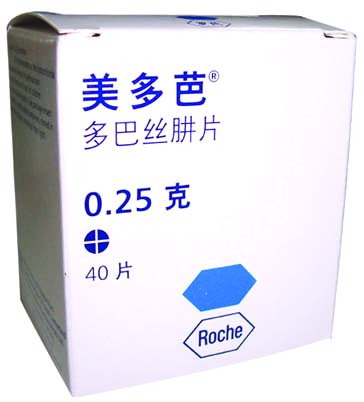|
【药品名称】 【功效】 本品适用于帕金森病,症状性帕金森综合症(脑炎后、动脉硬化性或中毒性),但不包括药物引金森综合症。。 【说明】 成份:美多芭是罗氏公司的专利产品,由左旋多巴:3-(3,4-二羟苯基)-L-丙氨酸和脱羧酶抑制剂羟苄丝肼:I-DL-丝氨酰-2-(2,3,4-三羟基苯甲基)联氨盐酸盐组成,其比例是4:1。 每片美多芭(十字刻痕)含200毫克左旋多巴和50毫克羟苄丝肼(盐酸盐)。能够只用片剂一种方式,便可根据需要有四种不同剂量的调整(1/4、1/2、3/4或1片)。 【性质】在帕金森综合症病人的基底神经节中缺乏多巴胺。与多巴胺不同,左旋多巴可穿过血脑屏障进入中枢,作为多巴胺的直接代谢前驱物,它使多巴胺替代疗法变成可行。可是,左旋多巴在大脑外迅速脱羧而转变成多巴胺,这就导致左旋多巴的大量浪费和不良反应的频繁发生。因此,抑制左旋多巴在脑外的脱羧作用是很有闪的。通过同时服用左旋多巴和脑外脱羧酶抑制剂可达到此目的。临床实践显示应用两者按4:1比例的复合制剂即芭,可获得良好的疗效,与大剂量的左旋多巴效果一样,且耐受性则要好得多。长期服用美多芭后,帕金林综合症的症状均有显著好转。 【适应症】帕金森病,症状性帕金森综合症(脑炎后、动脉硬化性或中毒性),但不包括药物引起的金森综合症。 【剂量与用法】美多芭最适宜的日用量必须根据不同病人的情况而定。 下面的用量表可作为一个基本的参考 ⒈初始治疗:首次推荐量是美多芭每次1/2片,每日三次。以后每周的日服量增加1/2片。直至达到适合该病人的治疗量为止。如病人定期就诊,则用量可增加得更快,例如日剂量每周增加二次,每次增加美多芭1/2片,这样就能较快达到有效剂量,有效剂量通常在每天2-4片之间,日分3-4次服用。每天的服用量很少需要超过5片美多芭。如果尚未得到令人满意的改善,则用量应进一步增加,但速度应更缓慢。 如果有必要每天给于4片以上美多芭片剂,那么增加剂量应以月为间隔期。 对于少数病人来说,应从1/4片到1/2片一直逐渐增加到相同的总日用量。 ⒉维持疗法:美多芭的日用量至少应分成3次服有,平均维持量是每天3次,每次一片美多芭。然而,由于症状的改善可能有波动,因此日剂量分配(就每一病人服用的剂量和服药的时间而言)视个别病人具体情况而定。如果病人在疗效上开始出现显著被动,这种状况通过服用美多芭1/4片常可得到显著改善。 原则上日用量不改变,可用1/4片美多芭部分或必要时全部取代原先的美多芭分配量,但要缩短间隔期: 原先服用的美多芭1/2片时,可用两次服用各1/4片来取代。 原先服用的美多芭1片,可用分4次服用各1/4片来取代。 3.过去服用左旋多巴现转用美多芭 如果过去服用左旋多巴治疗的病人需要改用美多芭1片片剂,改变的方法如下,每天服用美多芭的片数相当于病人现时日服左旋多巴500毫克/片片剂或胶囊总数的一半减1/2片。例如,病人日服2克左旋多巴(每日4片500毫克左旋多巴片剂或胶囊),医生开给他的美多芭处方应该是每日2-1/2=1 1/2片。对所有病人来说,最少的首次剂量每日二次,每次1/2片。 病人应当被密切观察一周,如有必要,美多芭的用量应增加,直至获得令人满意的疗效为止(用量时间表与以前未曾用过左旋多巴治疗的病人相同)如果观察到病人的临床状况恶化,增加用量的时间可提前。 4.一般注意事项:少数病例,在治疗初期就出现了较严重的不良反应,此时 就不应再进一步增加剂量,甚至应当减量。但很少需要中断治疗。当不良反应消失或可以耐受时,日剂量可重新增加,但应更缓慢,如每2-3周仅增加美多芭1/2片。当患者服用美多芭R超过了平时有效剂量(如每天服用美多芭3片以上),则剂量装置加的间隔期须长些,因为药物在治疗上达到充分的效果是需要一定时间。 如同所有的替代法一样,用美多芭来治疗也是长期的,如果治疗4周后,症状有所改善,则美多芭应继续服用,以获得良好的疗效。有时需要服用美多芭6个月以上,才能达到最佳效果。 【不良反应】用美多芭治疗可消除或减少单用左旋多巴后所引起的不良反应(即多巴胺的外周作用),特别是胃肠道的不良反应,同样,心血管方面的不良反应(如心律不齐、体位低血压等)也比用左旋多巴时少。然而,在治疗早期仍可发生一些不良反应:故此应劝告病人在进餐期间服美多芭,或至少辅以一些食物或饮料,并尽量避免高蛋白饮食后服药。此外,用量应慢慢地增加。可能出现诸如失眠、不安等症状。抑郁症和精神病则较罕见。 异常的不随意运动—舞蹈病样动作或手足徐动症可出现,但通常见于治疗晚期。 【注意事项】在用美多芭治疗期间,不应当给病人服单胺氧化酶抑制剂。美多芭可加强同时服用的拟交感神经药的作用。因此,密切监视心血管系统也是必不可少的。且拟交感神经药剂量亦应减少。其他的抗帕金森药不应当在美多芭治疗一开始就突然停服,因为后者的作用至少需几天才见效。在某些病例中,其他药的用量在以后应逐渐地减少。 对有心肌梗塞、冠状动脉供血不足或心律不齐的病人,应定期进行心血管系统检查(特别应包括心电图检查)。 治疗期间同时用各种抗高血压治疗是允许的,但应定期测量血压。在抗高血压药物中,利血平和α—甲基多巴可干扰多巴胺的代谢,因而可对抗美多芭的作用。对吩噻嗪、丁酰苯的衍生物来说也是如此。 在用低剂量的多种维生素制剂中,服用维生素B6是允许的。 患 胃、十二指肠溃疡或骨软化症的病人服用此药时应严密观察。 对患有青光眼的病人,应定期测量眼压。除急诊病例外,手术病人应在手术有2—3天停服美多芭。在恢复治疗后,用量可逐渐增加到手术前的水平。在紧急手术中,应避免使用环丙烷或氟烷麻醉。在手术期间,应对病人进行非常严密的观察。如同任何药的长期治疗一样,应定期检查血常规和肝、肾功能。 【禁忌症】使用美多芭的禁忌症与使用拟肾上腺素药(如肾上腺素、去甲肾上腺素及其衍生物)是一样的。严重的内分泌、肾脏、肝脏和心脏病患者,精神病和严重的精神神经病患者忌用此药。25岁以下的病人或孕妇不宜服用美多芭。 【包装】美多芭:十字刻痕每片含200毫克左旋多巴+50毫克苄丝肼,为40片包装。 药品应放在小孩接触不到处! 【剂型】 片剂 【单位】 40片/盒 【批准文号】国药准字H10930198 【生产单位】 ** This Product has been Discontinued and we can no longer supply it.
How does it work? This medicine contains the active ingredients levodopa and benserazide hydrochloride. It is used in Parkinson抯 disease to increase the levels of dopamine in the brain. Dopamine is a substance known as a neurotransmitter. Neurotransmitters are present in the brain and nervous system and are involved in transmitting messages between nerves. These messages allow the normal functioning of the body. The neurotransmitter dopamine is known to be reduced or absent in the brains of people with Parkinson's disease, and this is thought to be the cause of the disease symptoms. When you take levodopa, it is converted into dopamine in the brain. This replaces the lost dopamine and therefore reduces some of the symptoms of the disease. Unfortunately, levodopa is also converted into dopamine in the rest of the body, which can cause unwanted side effects such as nausea and palpitations. Benserazide hydrochloride is used in combination with the levodopa to prevent this happening. It blocks the conversion of levodopa to dopamine in the body and so prevents these side effects. (Benserazide cannot pass into the brain and so does not affect the conversion of levodopa to dopamine in the brain.) The combination of levodopa and benserazide is therefore effective in the treatment of Parkinson's disease, while minimising the side effects caused by levodopa on the rest of the body. What is it used for? Parkinson's disease Warning! People with diabetes should monitor their blood sugar carefully during treatment with this medicine. This medicine may be harmful to an unborn baby. Women of child-bearing age should use a reliable contraceptive method to prevent pregnancy while using this medicine. You should have regular tests to monitor the function of your liver, blood, kidney and heart while taking this medicine. This medicine may colour your urine red. This is not harmful. If your symptoms start to improve on this medicine make sure you resume your normal activities gradually. Try not to do too much too quickly as you may risk injury. This medicine may cause drowsiness or psychiatric disturbances in certain people. If you are affected in this way, do not drive or operate machinery. This medicine may affect the results of certain laboratory tests, including those for testing glucose levels in blood or urine. If you have diabetes ask your doctor for further information about this. Tell your doctor that you are taking this medicine if you have any blood or urine tests. Use with caution in If you feel you have experienced an allergic reaction, stop using this medicine and inform your doctor or pharmacist immediately. Pregnancy and Breastfeeding This medicine should not be used during pregnancy as it may be harmful to the unborn baby. Women of child bearing potential should use adequate contraception to prevent pregnancy while taking this medicine. Seek medical advice from your doctor. This medicine may pass into breast milk, therefore mothers taking this medicine must not breastfeed. Discuss with your doctor. Label warnings This medication may cause your urine to be coloured. Side Effects difficulty in sleeping (insomnia) The side effects listed above may not include all of the side effects reported by the drug's manufacturer. For more information about any other possible risks associated with this medicine, please read the information provided with the medicine or consult your doctor or pharmacist. How can this medicine affect other medicines? The following medicines should be avoided while taking this medicine as they may interfere with the effect of levodopa: opioids, eg morphine If they are essential, you and your doctor should keep a look out for any increased or decreased effects and any unusual side effects while taking the combination. If this medicine is taken with medicines to treat high blood pressure (antihypertensives), your blood pressure may drop too low, making you feel dizzy or lightheaded. Your doctor may need to adjust the dose of the antihypertensive. Sympathomimetic medicines, such as the following, may increase the risk of side effects on the heart and should only be used in combination with this medicine on medical advice: decongestants, eg ephedrine, phenylephrine Iron preparations, eg ferrous sulphate, may decrease the absorption of this medicine from the gut. Benzodiazepines, eg diazepam, may decrease the therapeutic effects of this medicine. Tricyclic antidepressants, eg amitriptyline, may decrease the therapeutic effects of this medicine, and may also rarely increase the risk of a dangerous rise in blood pressure (hypertensive crisis). This medicine can be used with other medicines for Parkinsondisease, eg anticholinergics, amantadine, dopamine agonists or COMT inhibitors, however both the desired effects and side effects of treatment may be intensified. Your doctor may need to adjust the dose of one or more of your medicines to get the correct balance. |


